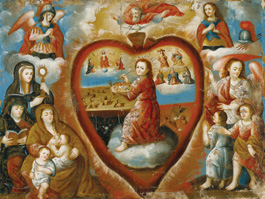home | metro silicon valley index | the arts | visual arts | review

Photograph by Dixie Sheridan
Heart of the Matter: The Peruvian painting 'The Christ Child Painting the Four Last Things' depicts Jesus as an artist.
New World Visions
The Cantor's 'Virgin, Saints and Angels' exhibit shows the migration of European themes and styles to a new continent
By Michael S. Gant
A SCYTHE-TOOTHED behemoth snorting blood opens wide as a horned demon prods sinners into its ravenous maw. Unfortunate reprobates suffer on a wheel studded with blade points. No one gets out of here alive: five church fathers sit in a vat of boiling blood.
You can't accuse the anonymous 17th-century Peruvian artist responsible for the enormous Last Judgment (about 9-by-6 feet), on display in "The Virgin, Saints and Angels" exhibit at the Cantor Arts Center, of understatement. The artist tells the whole apocalyptic story, from the tiers of saints surrounding Christ the Judge at the top all the way down a sweeping S-curve of despair leading to a graveyard where corpses squirm to the surface like so many reanimated worms to receive the Lord's verdict. But it is the lower quarter of the painting, the one closest perhaps to a kneeling Indian supplicant, that must have induced the most shock and awe.
San Francisco.com Real Estate
Moving to the Bay Area just became easy. Let San Francisco.com show you all the homes currently for sale.
San Jose.com Real Estate
Relocating to San Jose or Silicon Valley? Let San Jose.com introduce you to some expert area real estate agents.
The Spanish conquerors produced paintings like this in abundance to instruct and to frighten native peoples into submission to the imposed religion. As the catalog for the show notes, "The more lurid the visual message, the more effective a weapon it was against idolatry." (And now, in an ironic twist on colonialism, Hugo Chavez returns the favorite by spooking us with his rhetorical image of Bush the devil.)
The 50-plus paintings in the show, selected from the private Thoma collection, cover the peak years (1600-1825) of the Spanish hegemony in the Viceroyalty of Peru (South America minus Brazil). Mostly religious, with a few secular portraits, the works demonstrate the complex ways in which the New World interpreted the motifs and techniques of Old World artists. Many of the paintings are copies of European prints, which circulated widely; others represent the teachings of Spanish artists working in the Americas.
A late-1700s Ecuadorian Noah's Ark adds some New World animals—armadillos and turkeys—to the parade of fauna queuing up for a berth. Some Amerindians accompany Noah. The picture bursts with a charming vitality. Flocks of swooping birds descend on the ship's roof beam, while a lone mythical monster hopes to sneak aboard, too.
South American parrots in riotous plumage appear in the background of The Marriage of the Virgin from Peru. A single jungle denizen with a magnificent long red and blue tail sits on a bar preening, oblivious to the drama of The Visitation taking place in the foreground. In a curious way, these avian details link up to "Vanishing Worlds," the Cantor's show last year of ritual objects from remote Amazon tribes, who often crafted ceremonial garments from parrot feathers in the same hues.
An 18th-century painting presents The Trinity as three identical seated, bearded kings in full regalia against a flat gold backdrop, as opposed to the more common iconography of the Father, the Son and the Holy Ghost as a dove. This almost Byzantine scheme, according to the exhibit's notes, flourished in Peru as a more effective way of explicating to the locals the mysterious notion of the Trinity.
For the most part, these paintings were meant to be seen in candle-lit churches and monasteries and used as meditation aids, not as objects of aesthetic contemplation. Seeing them arranged under the spotlights of a museum alters the essential dynamic of their creation. Still, the best works stand out on their own terms, even for the nonbeliever.
The anonymous The Christ Child Painting the Four Last Things functions as a surreal glimpse of the end of days worthy of Dali. Palette in hand, the Christ daubs at a mural of the last judgment, with a sly grin on his face (the idea of the savior as an artist must have secretly pleased some humble painter). Surrounded by the usual panoply of saints and virtues, Christ sits inside the outline of a human heart depicted with almost anatomical correctness, down to the two veined aorta through which God peers at his precocious offspring.
The Virgin, Saints and Angels: South American Paintings 1600-1825 runs through Dec. 31 at the Cantor Arts Center, Stanford. Free. (650.724.4177)
Send a letter to the editor about this story.
|
|
|
|
|
|
